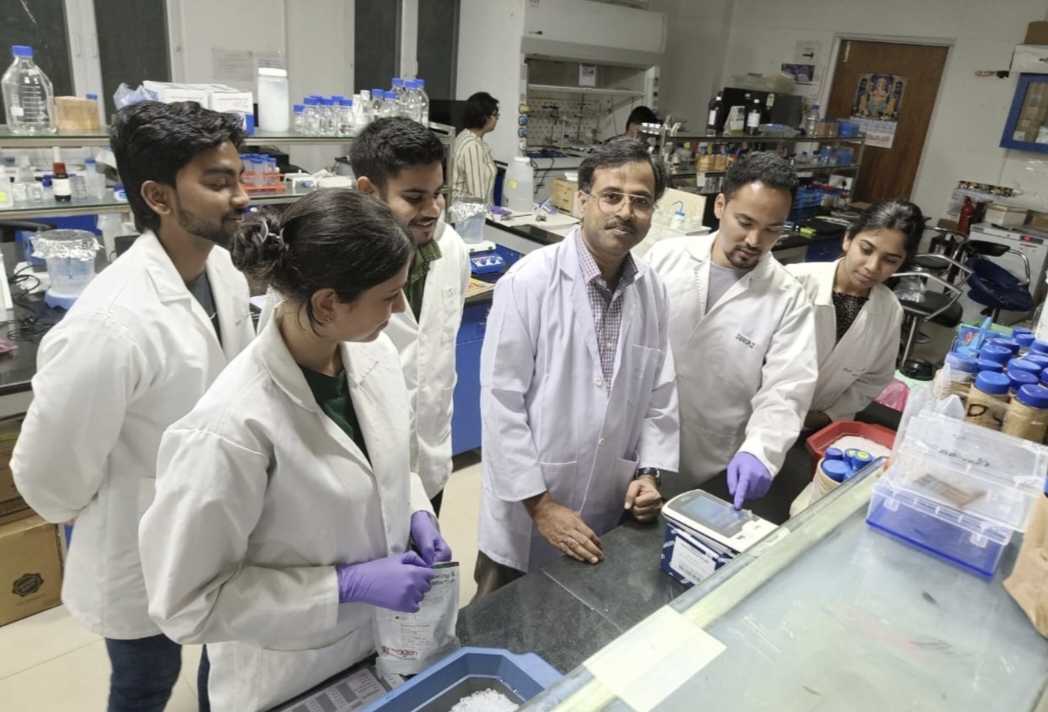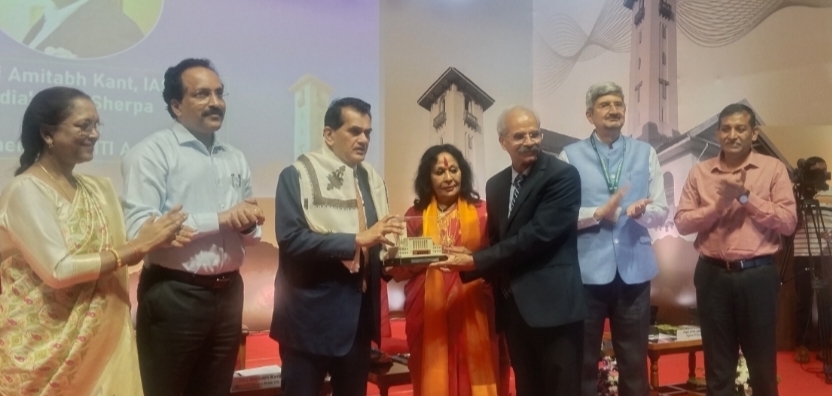







आईआईटी मंडी के शोधकर्ताओं ने पोर्क टैपवार्म के विरुद्ध एक प्रोटीन-आधारित वैक्सीन बनाने का दिया प्रस्ताव
इस शोध में टीम ने प्रोटीन अध्ययन और बायोइंफॉर्मेटिक्स को एकत्र करके टीके के लिए सुरक्षित और प्रभावी प्रोटीन टुकड़ों की पहचान की है, जो समान उपेक्षित उष्णकटिबंधीय बीमारियों के लिए टीके विकसित करने के लिए एक नया दृष्टिकोण प्रदान करता है।

Video Link – https://drive.google.com/drive/folders/1AyVJK3AwBea31WWBuXXWCZMU6YSZqUYI
मंडी, 26th सितंबर 2023: भारतीय प्रौद्योगिकी संस्थान मंडी के शोधकर्ताओं द्वारा सुअर के मांस से सम्बंधित टैपवार्म (T. solium) के विरुद्ध टीकों के विकास में महत्वपूर्ण प्रगति की है। यह शोध स्कूल ऑफ बायोसाइंसेस और बायोइंजीनियरिंग के एसोसिएट प्रोफेसर डॉ. अमित प्रसाद के नेतृत्व में किया गया है। यह टैपवार्म आंत्रिक संक्रमणों के अलावा उच्च गंभीर मस्तिष्क संक्रमण के लिए भी जिम्मेदार है जिससे मिर्गी भी होती है। इस शोध को पंजाब के दयानंद मेडिकल कॉलेज और हॉस्पिटल के वैज्ञानिकों एवं हिमाचल प्रदेश के सीएसआईआर-हिमालयान बायोरिसोर्स प्रौद्योगिकी संस्थान के वैज्ञानिकों के सहयोग से किया गया है। यह शोध चुनौतीपूर्ण संक्रामक बीमारियों के लिए टीकों का उत्पादन करने के लिए एक नवीन, तीव्र एवं अधिक प्रभावी दृष्टिकोण प्रदान करता है।
विश्व स्वास्थ्य संगठन पोर्क टैपवार्म को खाद्य जनित बीमारियों से होने वाली मौतों का एक प्रमुख कारण के रूप में देखता है, जिससे दिव्यांगता के साथ ही जीवन का भी नुकसान होता है। विकासशील देशों में 30% मिर्गी के मामलों में इसका योगदान है, जो गंदगी और स्वतंत्र रूप घूमते फिरते सूअरों वाले क्षेत्रों में 45%-50% तक बढ़ सकता है। उत्तर भारत में मस्तिष्क संक्रमण का प्रसार चिंताजनक रूप से 48.3% के उच्च स्तर पर है। विश्व स्वास्थ्य संगठन के “2030 रोडमैप ऑफ़ नेगलेक्टेड ट्रॉपिकल डिजीज” का उद्देश्य टी. सोलियम और इसी तरह के संक्रमणों का मुकाबला करना है, जिनसे वैश्विक स्तर पर 1.5 बिलियन लोगों प्रभावित होते हैं।
जबकि एल्बेंडाजोल और प्राजिक्वेंटेल जैसी कृमिनाशक दवाओं का बड़े पैमाने पर सेवन कराया जा रहा है किन्तु इसमें सार्वजनिक भागीदारी में कमी और दवा प्रतिरोध के बढ़ते जोखिमों के कारण कई चुनौतियों का सामना करना पड़ रहा है। परिणामस्वरूप इस पद्धति से वांछित परिणाम प्राप्त नहीं हुए हैं।
इसलिए डॉ. अमित प्रसाद ने लोगों को पोर्क टेपवर्म से बचाने के लिए एक टीके की तत्काल आवश्यकता पर बल दिया है।
परंपरागत रूप से टेपवर्म से सम्बंधित टीके टेपवर्म के अंडो या लार्वा से प्राप्त उत्पादों या एंटीजन का उपयोग करके विकसित किए गए हैं। हालाँकि यह तरीके हमेशा विश्वसनीय नहीं होते हैं और इनमें काफी समय भी लग सकता है।
शरीर की प्रतिरक्षा प्रणाली को सक्रिय करने के लिए पूरे टेपवर्म या टेपवर्म के कुछ हिस्सों को इंजेक्ट करना एक सुरक्षित या व्यावहारिक दृष्टिकोण नहीं है। जबकि एक बेहतर और सुरक्षित तरीका यह है कि टेपवर्म से केवल विशिष्ट प्रोटीन या अंशों को मानव में इंजेक्ट किया जाए। यह प्रक्रिया दुष्प्रभावों को कम करती है और टेपवर्म को टीके के प्रति प्रतिरोध विकसित करने से रोकती है।
मजबूत टीकाकरण क्षमता वाले सही प्रोटीन टुकड़े की पहचान करना एक अधिक मेहनत और समय लेने वाली प्रक्रिया होती है। जबकि टेपवर्म वैक्सीन के विकास की प्रगति में तेजी लाने के लिए एक अधिक नवीन और कुशल दृष्टिकोण आधरित प्रक्रिया की आवश्यकता है। इसलिए आईआईटी मंडी के शोधकर्ताओं ने एक ऐसी विधि विकसित की है जिसमें प्रोटीन अध्ययन और जैव-सूचना विज्ञान के संयोजन का उपयोग किया गया है।
अपने इस शोध के बारे में विस्तार से बताते हुए आईआईटी मंडी के स्कूल ऑफ बायोसाइंसेज एंड बायोइंजीनियरिंग विभाग के एसोसिएट प्रोफेसर डॉ. अमित प्रसाद ने कहा, “इस शोध में सबसे पहले हमने टेपवर्म के सिस्ट तरल पदार्थ के विशिष्ट एंटीजन की पहचान की है जो रोगियों के रक्त सीरम के साथ परीक्षण करके प्रतिरक्षा प्रणाली को ट्रिगर करते हैं। इसके बाद हमने सुरक्षित और प्रभावी प्रोटीन टुकड़े खोजने के लिए प्रतिरक्षा-सूचना विज्ञान उपकरणों का उपयोग करके इन एंटीजन का विश्लेषण किया है। हमने आकार, स्थिरता और प्रतिरक्षा प्रणाली के साथ अनुकूल कारकों को ध्यान में रखते हुए एक मल्टी-पार्ट वैक्सीन बनाने के लिए इन टुकड़ों को संयोजित किया है।”
इस अनुसन्धान में शोधकर्ताओं ने यह पाया कि टीका प्रतिरक्षा रिसेप्टर्स के साथ प्रभावी ढंग से प्रतिक्रिया करता है और इससे शरीर की प्रतिरक्षा प्रणाली को प्रभावी रूप से प्रोत्साहित करने की उम्मीद की जानी चाहिए। यह शोध भविष्य में इसी तरह के परजीवियों के कारण होने वाली उपेक्षित उष्णकटिबंधीय बीमारियों के खिलाफ टीके विकसित करने के लिए एक आधार प्रदान करता है। इस आशाजनक वैक्सीन की सुरक्षा और इसके प्रभाव का मूल्यांकन करने के लिए अभी पशु और नैदानिक अध्ययन की आवश्यकता है।
जैव सूचना विज्ञान के साथ प्रोटीन अध्ययन का संयोजन एक लागत प्रभावी और समयबद्ध तरीके से संभावित प्रोटीन-आधारित टीकों की पहचान करने के लिए एक शानदार दृष्टिकोण है। यह केंद्रित प्रयास स्वास्थ्य कर्मियों को न्यूरोसिस्टीसर्कोसिस से निपटने के लिए एक नया उपकरण प्रदान कर सकता है और अन्य उपेक्षित उष्णकटिबंधीय रोगों के समाधान के लिए एक मॉडल के रूप में काम कर सकता है।
इस शोध कार्य के विवरण को यूएसए के जर्नल ऑफ सेल्युलर बायोकैमिस्ट्री में प्रकाशित किया गया है और इसके सह-लेखक डॉ. रिमनप्रीत कौर, प्रोफेसर गगनदीप सिंह, डॉ. नैना अरोड़ा, डॉ. राजीव कुमार, श्री सूरज एस. रावत और डॉ. अमित प्रसाद हैं। इस पेपर को https://onlinelibrary.wiley.com/doi/abs/10.1002/jcb.30467 इस लिंक पर जाकर पढ़ा जा सकता है।
###
IIT Mandi Researchers Propose a Protein-based Vaccine against Pork Tapeworm
The team has combined protein studies and bioinformatics to identify safe and effective protein fragments for the vaccine, offering a novel approach for developing vaccines for similar neglected tropical diseases
Video Link – https://drive.google.com/drive/folders/1AyVJK3AwBea31WWBuXXWCZMU6YSZqUYI
MANDI, 26th September 2023: Indian Institute of Technology Mandi researchers, led by Dr. Amit Prasad, Associate Professor, School of Biosciences and Bioengineering, has made significant strides in the development of vaccines against the pork tapeworm (T. solium).
This tapeworm is responsible for both intestinal infections and the more severe brain infection that leads to seizures. Their research, conducted in collaboration with scientists from Dayanand Medical College and Hospital in Punjab and the CSIR-Institute for Himalayan Bioresource Technology in Himachal Pradesh, presents a novel, faster, and more effective approach to producing vaccines for challenging infectious diseases.
The WHO identifies the pork tapeworm as a major cause of foodborne deaths, causing substantial disability-adjusted life year losses. It contributes to 30% of epilepsy cases in developing nations, rising to 45%-50% in areas with poor hygiene and free-roaming pigs. In North India, brain infection prevalence is alarmingly high at 48.3%. WHO’s “2030 Roadmap of Priority Neglected Tropical Diseases” aims to combat T. solium and similar infections affecting 1.5 billion people globally.
While the mass administration of deworming drugs such as Albendazole and Praziquantel has been a common approach, it has encountered challenges, including reduced public participation and an increased risk of drug resistance. As a result, this method has not achieved the desired results.
Dr. Amit Prasad emphasized the urgent need for a vaccine to protect people against the pork tapeworm.
Traditionally, tapeworm vaccines have been developed using products or antigens derived from tapeworm eggs or larvae. However, these methods are not always reliable and can be time-consuming.
Injecting the entire tapeworm or parts of the tape worm to kick start the body’s immune system is not a safe or practical approach. A better and safer method is to inject only specific protein fragments from the tapeworm into the human. This approach minimizes side effects and prevents the tapeworm from developing resistance to the vaccine.
The identification of the right protein fragment with strong vaccination potential is a painstaking and time-consuming process. A more innovative and efficient approach is needed to expedite progress in tapeworm vaccine development and the IIT Mandi researchers used a combination of protein studies and bio-informatics to develop a method of selection.
Elaborating on their research, Dr. Amit Prasad, Associate Professor, School of Biosciences and Bioengineering, IIT Mandi, said, “First, we identified specific antigens from the cyst fluid of the tapeworm that trigger an immune response by testing them with the blood serum from patients. Then, we analysed these antigens using immune-informatics tools to find safe and effective protein fragments. We combined these fragments to create a multi-part vaccine, taking into account factors such as size, stability, and compatibility with the immune system.”
The researchers discovered that the vaccine interacted effectively with immune receptors and should stimulate the body’s defense system efficiently. This research establishes a foundation for developing vaccines against neglected tropical diseases caused by similar parasites in the future. Further animal and clinical studies are needed to evaluate the safety and efficacy of this promising vaccine candidate.
The amalgamation of protein studies with bioinformatics is a groundbreaking approach for identifying potential protein-based vaccines in a cost-effective and timely manner. This concentrated effort may provide a new tool for healthcare workers to combat neurocysticercosis and could serve as a model for addressing other neglected tropical diseases.
The details of this work have been published in the USA’s Journal of Cellular Biochemistry and co-authored by Dr. Rimanpreet Kaur, Prof. Gagandeep Singh, Dr. Naina Arora, Dr. Rajiv Kumar, Mr. Suraj S. Rawat, and Dr. Amit Prasad. The paper may be accessed at https://onlinelibrary.wiley.com/doi/abs/10.1002/jcb.30467.
###



















Leave a Reply